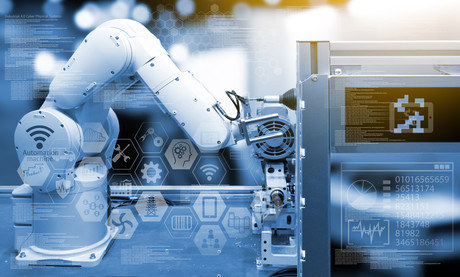Smart Industry and the factories of the future

With a new year comes new hope for the promises of Smart Industry — a phenomenon that is revolutionising manufacturing in ways we could previously only dream of. To learn more about this trend, What’s New in Electronics spoke with Sapna Mongia, Head – Smart Grids and Metering, South Asia, Power and Discretes, from semiconductor supplier STMicroelectronics (ST).
Smart Industry, Industry 4.0, the Fourth Industrial Revolution… what exactly is this thing that has the world’s engineers so excited? Mongia defines Smart Industry as “the vast deployment of sensors, actuators and processing capabilities, together with the collection and analysis of the data they produce, to monitor and report on the critical points in industrial environments, to increase efficiency, reduce costs and move from preventive to predictive maintenance”. She added that it encompasses a number of key trends, including:
- next levels of automation with distributed control;
- safer working environments and new man-machine interaction models;
- higher energy efficiency for industrial machinery;
- the capture and use of manufacturing data;
- the application of artificial intelligence and machine learning.
Smart Industry includes high-growth application areas such as factory automation, industrial robots and industrial lighting, according to Mongia — areas which ST is well acquainted with through its large range of motor control ICs, industrial analog ASICs, sensors, actuators and microcontrollers. Applications include building control, manufacturing and process automation, medical electronics, military and civil aerospace, test and measurement, power and energy, security and video surveillance, and industrial 3D printers.
One of the key benefits of Smart Industry is improved factory automation, with Mongia stating, “Initiatives such as Industry 4.0 and the Industrial Internet of Things (IIoT) are defining the next phase in the digitisation of the manufacturing sector towards better efficiency, flexibility and safety.
“Smart, aware machines are creating new ways for man and machine to interact in the factory,” she added.
Furthermore, with improved factory automation comes improved power management — a particularly important development as, according to Mongia, “The industrial sector uses over 50% of the world’s energy, and about half of the energy used by industrial manufacturers is used to drive machines.”
A growing focus on energy saving and increased labour safety is thus opening up new opportunities for industrial system developers, stated Mongia. “System designers are addressing these evolving challenges using advanced semiconductor power technologies and their derived system-oriented power-saving and efficient products,” she said.
Smart Industry’s reliance on semiconductors means ST is able to provide the factory and process automation industry with an extensive product portfolio, ranging from Arm Cortex-M-based microcontrollers to memories, discrete power products, analog ICs, MEMS sensors and actuators, and more. The company’s industrial power supplies meanwhile enable energy-saving, high-power density and lower standby-power design solutions.
Another significant part of Smart Industry is robotics, specifically motion control. As explained by Mongia, “Motion control is used everywhere that a motor is involved in moving something. Whether this is for huge turbines or tiny medical robot arms, the basic principles are the same, and the motion control circuitry must deliver performance and power optimised to the application.”
In addition, the importance of power management cannot be understated, with Mongia noting that electric motors consume up to 70% of the power used in a typical factory. Thus, she said, “Advances in motion control are focused on driving motors with optimal performance and power efficiency.
“Improvements can be made through a focus at all points in the power distribution, consumption and harvesting cycle involved in motor control,” Mongia added. “As an example, existing machinery can be retrofitted with new — and more efficient — inverters and power management boards.”
Mongia noted that ST has particular expertise in advanced motion control, offering solutions for various applications. Examples include washing machines that use variable-speed motor-control technology to reduce power consumption powered by devices like ST’s STCH02 and Viper0P. Advanced Motion-Control Chips such as ST’s STSPIN820 IC meanwhile enable stepper-motor-based robots to achieve smoothness and silence, with small size, precision and low power consumption.
Finally, it would be remiss of us to talk about industrial robotics without mentioning 3D printing, which has “greatly enhanced accuracy and throughput in recent years”, according to Mongia.
“3D printers can produce parts with complex shapes, quickly and accurately, and are becoming more and more affordable, for consumer and professional uses from prototyping to production,” she added.
The STSPIN820 IC is particularly notable for its high-speed inputs and precise micro-stepping algorithm, enabling it to turn a motor by a fraction of a degree to move a 3D printer’s head at a speed of more than 500 mm/s. This submicron precision allows it to create parts quickly and with good surface finish, as well as to control precise movements like sample loading, capping/decapping and storage/retrieval in next-generation clinical automation systems.
So which industry sectors should be looking to ST and other suppliers to improve their factory automation? Mongia stated that “all factories are reasonable targets for improved factory automation”, and are set to benefit as a result.
“Factories of the future will be more environmentally friendly and productive and they will also be much more flexible and better able to respond to changes in demand and low-volume production requirements,” she said.
“As a supplier with over 30 years’ experience in developing products for factory automation and industrial applications, ST is among the leaders in designing and manufacturing products that help make Smart Industry a reality, today.”

Electric dump valves help oil and gas company reduce emissions
Oil and gas company Laramie Energy deployed ASCO zero-emissions electric dump valves to comply...
Australia's largest electronics expo returns to Sydney
Electronex, the annual electronics design and assembly expo, will return to Sydney on 19–20...
The fundamentals of Australian RCM compliance
The following information aims to help readers understand the Australian compliance requirements...





